The more time you spend in your RV, the more likely you are to experience a toilet issue or two.
Full-time RVers will know full well what I am talking about. In any case, these are a myriad of reasons that your RV toilet is backed up or clogged.
The most common reason is something called a pyramid plug. Now, you may think that RV toilet backups couldn’t be much different than a regular toilet in your home.
This is not the case. RV toilets need to be treated differently than traditionally plumbed toilets. There are several ways you can address a clogged RV toilet, and we will cover most of them.
We are going to focus in more detail on how to unplug a pyramid plug as it is the most common.
So, How Do I Unclog My RV’s Toilet That Won’t Drain? Follow these seven easy steps to unclog your RVToilet or Black Water Tank:
- Close black tank valve
- Add water to the tank
- Pour a bottle of Holding Tank Cleaner into the tank
- Let the cleaner sit for 12-27 hours
- Open valve to empty the tank
- Rinse the tank
- Close the black tank valve
In this article, we will cover not only how to unclog a pyramid plug, but a few other methods to try for a quick fix.
Additionally, we will give you tips and tricks to prevent clogs in the future.
We will also be answering some frequently asked questions regarding RV toilets at the end of the article.
How to Unclog an RV Toilet?
Anytime you need to unclog your RV toilet or deal with a toilet matter of a different kind, you should proceed with caution.
Although the method we will focus on is one of the easiest and most effective, there is still waste involved.
So, be sure to follow these instructions correctly, and if you can, have another person there to help you.
If you unclog the toilet properly, the waste will simply flow into the sewer, and you can go about your business as usual.
Before we get into the steps of how to unclog your toilet, let’s talk a bit more about pyramid plugs.
The most common reason for RV toilets to be clogged and won’t flush is a buildup of toilet paper and waste at the base of the black holding tank. The clog will begin where the tank drains into the sewer and gradually build up until it reaches the toilet.
It essentially makes a pyramid shape while plugging the waste outlet of the tank, hence the name.
So, with that in mind, the tank itself is not clogged, but there is a pyramid of toilet paper and waste blocking water from allowing the waste to evacuate the tank.
Materials Needed
Before you get started, you should gather the proper materials.
- Disposable gloves
- RV Holding Tank Cleaner
As we are going over the preferred method first, the materials needed are rather slim.
When using an RV Holding Tank Cleaner, you won’t have to worry about using a plumber’s snake at all.
Using a snake can be effective but is often labor-intensive, and it can be messy.
Steps to Unclog Your RV Toilet That won’t drain
Luckily, a pyramid plug doesn’t have to be a huge undertaking. The number one thing that you will need to remember when using an RV Holding Tank Cleaner is that it takes time to work properly.
So, plan to do this right before bed or if you have access to another toilet for a day or two.
1: Unclog an RV Toilet Using a Holding Tank Cleaner
If you use a cleaner other than the one we recommended above, make sure that the one you’ve chosen is septic safe.
Other Unclogging Methods to Try
So, while the RV Holding Tank Cleaner method is preferred to unclog RV toilet. There are a few other unclogging methods you can use.
2: Use a Plunger To fix a clogged RV toilet
A traditional method that can work in an RV if there is only a minor obstruction.
This is often everyone’s first choice when attempting to clear their RV toilet as it is the one we use for toilets in our homes.
Although this can work, it isn’t always the most effective. The suction and force of the plunger will only be strong enough to unclog the RV toilet if the clog is near the top.
If there is a clog deeper down in the black water tank, a plunger will not be able to fix the issue.
3: Using Plumber’s Snake to clear a clog from your RV’s toilet
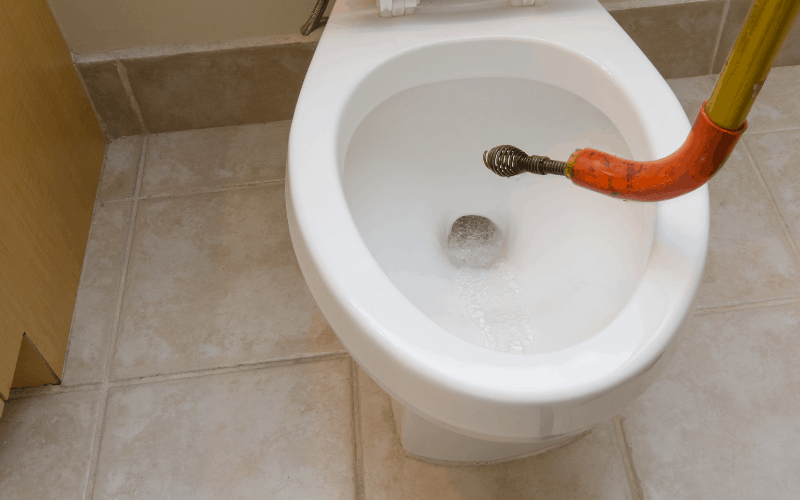
A flexible snake can help you to work a clog out of the RV toilet. If the clog is severe, a snake may not be as effective.
Be cautioned that this can be messy. To do this, you should have another person help you, and you will need the following materials:
- An easily bendable plumber’s snake
- Eye protection
- Disposable gloves
- Disposable clothing
- A bucket
Once you’ve gathered the materials to do this, you can proceed with the following process to clear your clog with a plumber’s snake.
4: Use boiling water to unclog RV toilet
Similarly to the tank cleaner, you can use boiling water to help break up the materials causing a clog in your RV toilet.
The main reason that RV toilets clog is due to lack of moisture in the tank. So, the hot water adds the moisture the materials need to break apart. Hot water works best as it is more aggressive in liquifying waste.
To to unclog an RV toilet with the boiling water, all you have to do is boil some water and pour it into the RV toilet. Flush the toilet so it enters the tank and let it sit for a few hours.
You can also pour water directly into the tank itself, but it helps to have the water work its way through the entire system.
If after a few hours you still have a clog, try again with more hot water. It may take a few tries depending on how large of a backup there is in the tank.
5: unclog an RV toilet with the ice cube method
The ice cube trick essentially works the same as the hot water method. Some RVers prefer this over the hot water but it all depends on the clog’s severity.
To to unclog an RV toilet with the ice cube all you have to do is fill your toilet 1/3 up with water and then add as many ice cubes as you can. Flush the toilet. Then, continue flushing the toilet as you drive your RV around. Add more ice cubes and water if the toilet is still clogged.
6: Dealership
If all else fails, you can take your RV to a dealership to get them to use a tank wand to spray the clog out.
Their high-pressure tank wands break up materials enough to allow them to pass. In most cases, this will cost you around $100-200.
Signs You Have an RV Toilet Problem
While some signs of RV toilet back-ups are apparent, there are little signs that you can look out for as well.
Knowing when your toilet is on the verge of being clogged is ideal because you can catch the problem earlier.
Here are the top signs that your RV toilet may be having some issues:
1: There is a strong odor coming from the toilet, black water tank, or the hose.
2: There may not be a clog that you can see, but if there is a distinct odor, then something isn’t draining correctly.
3: Your black water tank valve is hard to open, and once you open it, it doesn’t seem to drain.
4: When you are draining your tank, you don’t see or hear anything happening.
5: The valve is open, and the tank should be draining, but if the tank isn’t empty after a drain attempt, then you likely have a clog.
How to Prevent Toilet Backups in the Future
Beyond catching a clog early, there are several things you can do to prevent a clog from happening in the first place.
Making these aspects a part of your RVing life or maintenance routines can keep you from having to deal with nasty toilet clogs ever again.
1: Keep Your Black Water Tank Valve Closed
This was mentioned earlier, but it is vital in preventing clogs, especially pyramid plugs, so we will go into more detail here.
The reason keeping the valve closed on your black water tank is because when it is closed during regular use, the solid waste, toilet paper, and water can all mix and slosh around.
As the solids and liquids mix, the liquid can help break down materials.
Then, when you do dump the tank, they will be able to come out smoothly in a continuous flow.
When you choose to leave the black water tank valve open during regular use, all of the water and waste flow out of the tank and into the sewer line.
Usually, the water will drain much faster than the solids, leaving the solids sitting in the tank.
The tank is flat on the bottom, so it is easy for solids to get trapped when there isn’t enough liquid to help them drain.
So, as you use your toilet, more and more solids will begin to build up without liquids in the tank to help them break down.
Eventually, they will clog the sewer line and block any waste from draining.
2: Use More Water When Flushing
Water is what is moving your waste and toilet paper through your tank and into the sewer.
So, if you aren’t using the right amount of water, then your RV toilet will frequently become clogged.
You can avoid this by flushing the toilet twice after each use.
The more water that you’re using when you flush your RV toilet, the easier it will be for the materials to move and break down.
So, the more water you use, the less likely you will have a clog.
3: Choose the Correct Toilet Paper
Not using the correct toilet paper in an RV can cause some significant issues.
Since you will depend on a septic system, you need to make sure that the toilet paper you use is septic safe.
To find this, you can look for toilet paper labeled “septic safe” or “certified safe 2-ply.” The thicker, more expensive toilet papers will not work in an RV septic system.
They need to be thin enough to break down quickly with water.
You should also avoid flushable wipes. If you use wipes, dispose of them in the garbage, not the toilet.
4: Use Drop-In RV Toilet Cleaners
There are also chemical drop cleaners that you can use both in your kitchen and bathroom.
Since there are many types of these drop-in cleaners on the market, you need to make sure that when you buy one that it is septic safe.
Certain cleaners like a tissue digester, blue max drop, or a probe cleaner will do the trick in your RV bathroom.
Depending on the cleaner you purchase, how often you use it will differ. Make sure that you read their instructions and only use it as directed.
5: Regular RV Toilet and Black Water Tank Maintenance
One of the best ways to skip a pesky toilet clog is by performing regular RV toilet and black water tank maintenance.
This should involve a maintenance check schedule as well as certain cleaning tasks you perform every month and every year.
How often you perform these maintenance tasks will depend on how often you use your RV.
If you are a full-time RVer, you will need to do these things on a more frequent basis.
The best thing to do is to make sure you drain and clean your black water tank often.
This will give you a leg up on any clogs and likely prevent them from ever happening.
You can also choose to use the RV Holding Tank Cleaner we discussed above once a year when winterizing your RV to make sure things are completely cleared out.
Other Frequently Asked RV Toilet Questions
Can I Use Drano in My RV Toilet?
While Drano may seem like it would be a feasible option for unclogging an RV toilet, it is not recommended. Cleaners like Drano are caustic and can harm the plumbing of your RV.
If you use these types of cleaners often, it will break down the pipes and seals, making things even worse.
That is why we recommend only using cleaners that are labeled for RV use and that are septic safe.
How Do You Empty the Black Water Tank?
Knowing how to empty your black water tank is extremely important when unclogging or avoiding toilet clogs.
Follow the steps below to empty your tank properly:
- Step One: Attach a sewer hose to the dump station hole and black water tank.
- Step Two: Open the tank valve to let the tank drain.
- Step Three: When it seems the tank is emptied, close the valve and remove the connector slowly.
- Step Four: Close the black water tank valve.
One tip for making this process easier is to use a clear connector to attach the sewage hose to the tank.
This way, you don’t have to depend only on sound to know when the tank is done draining because you can see what is coming out.

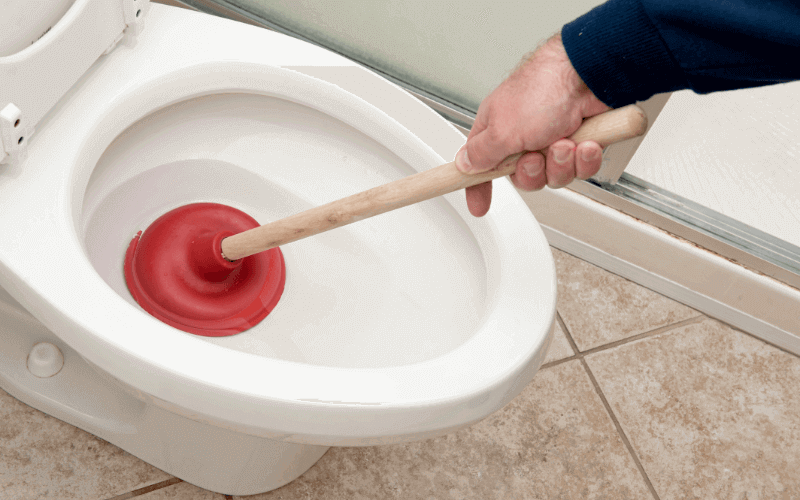
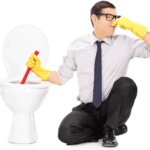
![10 Best RV Surge Protectors & Electrical Management Systems for [currentyear] (30 & 50 Amp) 3 RV Surge Protectors_ Why Do You Need One, & Which Is The Best](https://www.rvingknowhow.com/wp-content/uploads/2020/04/RV-Surge-Protectors_-Why-Do-You-Need-One-Which-Is-The-Best-150x150.jpg)
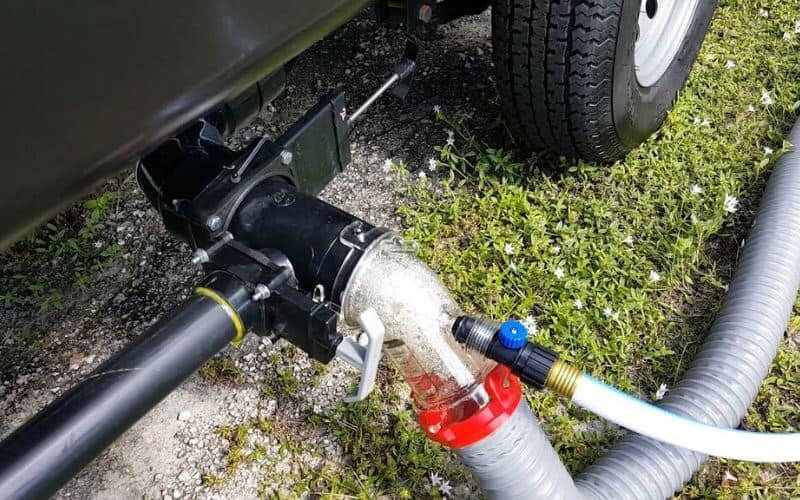
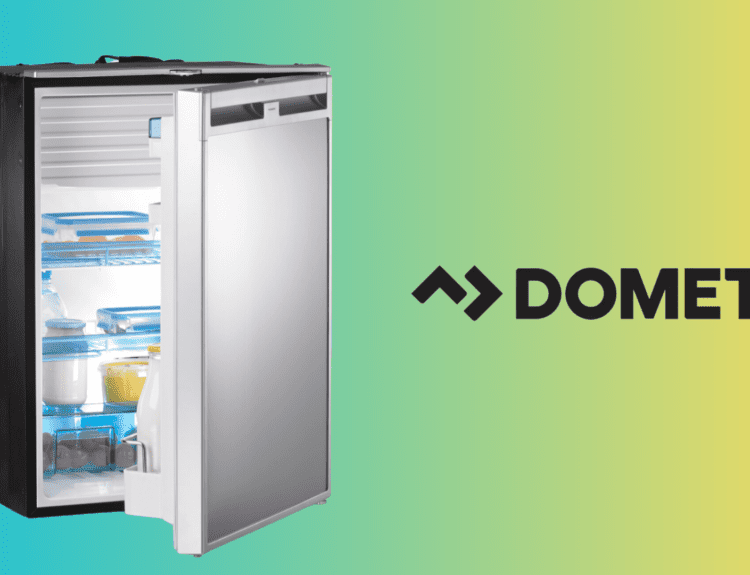
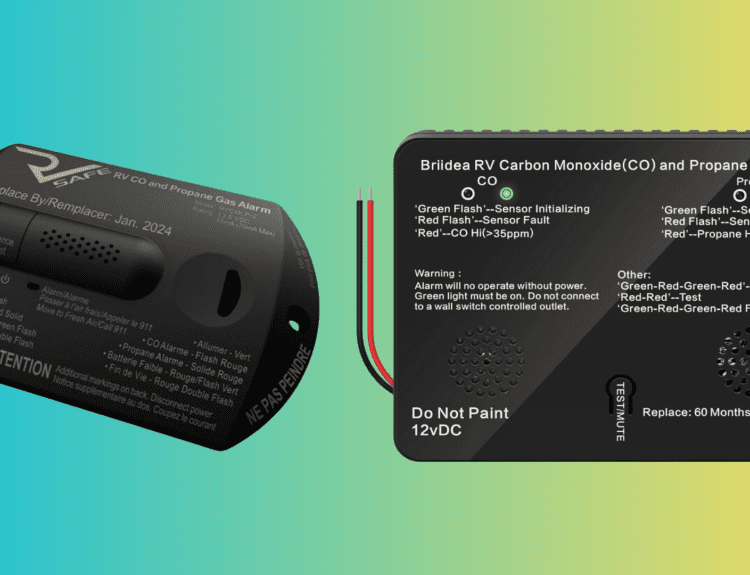
6 Comments
Lesa Ditterline
4 years agoThank you so so much. I read your entire content re the black and gray tank directions, problems, different options and prevention methods. Three months ago I moved into a fifth wheel trailor, being there on a part time basis. However my sinks suddenly backed up and drained into my bathtub. I used rid , along with putting a tube style hose down kitchen line and giving it a very hard blow several times. This seemed to work because. After I took a break then returned to do more blowing, both kitchen sinks and the bathroom sink are completely drained. However the bathtub is about half full without the plug in. I poured rid x in it also. I then ran hot water down all sinks to see if they were going to pool up again, they did not. And drained freely. So is it safe to determine the gray water tank is full? And my tub will not empty until it is emptied yes? Or is there still a clog somewhere in the line?
Aaron Richardson
4 years agoIf the grey water tank was actually empty and/or the water still does not drain out of the shower after dumping the grey water tank, then that means you have a clog in the pipes leading from your shower to the grey water tank. Yes, the drain pipes in an RV can get clogged just like the ones in your stick home.
Sean Carter
3 years agoWhat is best to unclog rv toilet?
Doug McGregor
3 years agoI am a newbie boondocker. My trailer sits permanently on our 52 acre woodland property. We installed a septic tank system and have left the tanks open. I realize now that this was dumb and water should always be in the tanks especially the black tank. My question is can l pressure wash the tank through the toilet? Would it be a good idea to plumb the toilet directly to the septic?
Cat
2 years agoYou can go tankless with a macerating toilet, but it could be a significant amount of work to do so. Some park model campers come from the factory with a macerating toilet, as they, like your rig, typically stay put year round.
Lakin Zoe
11 months agoAre there any ideals for tougher and denser clogs? A professional technician recommended using drain cleaners that exist on the market.